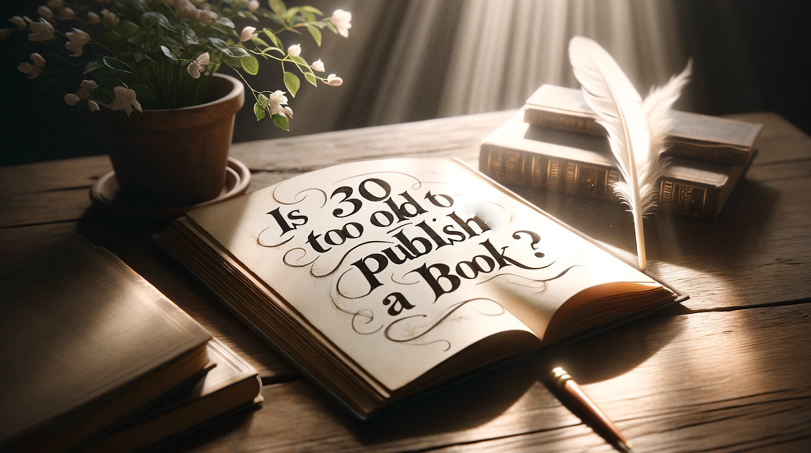
In the literary world, age often carries with it a tapestry of stereotypes and expectations, particularly when it comes to publishing one’s first book. There’s a prevailing mythos surrounding the age at which authors should publish their first book, often glamorizing the achievements of prodigious young writers who burst onto the scene with works that defy their years. This romanticization of youth in the publishing industry can cast a shadow of doubt and hesitation over older aspiring authors, leading many writers to question if there’s an invisible expiry date on their publishing dreams.
This article seeks to dismantle the age-old question: Is 30 too old to write and publish a book? Through a comprehensive exploration, we aim to challenge the stereotypes and unfurl the nuanced reality of the publishing journey. Whether you’ve been nursing a lifelong dream to see your name in print or have only recently felt the stirrings of a story within you, this piece is dedicated to understanding how age influences—or doesn’t—the path to publishing success.
The Age Myth in Publishing
The literary landscape is rife with tales of young literary prodigies who have etched their names in the annals of publishing history, seemingly setting a daunting standard for aspiring writers. The general assumption that percolates through the publishing industry and other writers, is that the younger you are, the more potential you have for a long and illustrious career. This perception is fueled by young writers like Mary Shelley, who penned “Frankenstein” at the young age of 18, and S.E. Hinton, whose seminal work, “The Outsiders,” was published when she was just 17. These remarkable achievements contribute to the myth that to be successful, one must start young and achieve early.
However, this narrative overlooks a significant portion of the literary world where authors have defied age norms and published their first works later in life. For instance, Raymond Chandler was 51 when “The Big Sleep” brought him into the limelight, showcasing his mastery of the detective story genre. Similarly, Frank McCourt won the Pulitzer Prize for his memoir, “Angela’s Ashes,” a book he published at the age of 66, proving that poignant storytelling and literary acclaim are not confined to the youth.
These contrasting examples serve to highlight the wide spectrum of possibilities in the publishing world for older writers. They underscore the fact that while younger writers can indeed bring fresh perspectives, new skills, and vibrant narratives to the table, older authors contribute depth, maturity, and a wealth of life experience that can enrich their storytelling. The age myth in publishing, therefore, is not only misleading but also limiting, as it discounts the diverse array of voices that emerge at different stages of life. The key takeaway is that the journey to publishing success is as varied as the individuals who embark on it, and age, rather than being a barrier, can be an asset in crafting compelling narratives.
Your Publishing Journey Awaits – Start NowUnderstanding the Publishing Industry
With its myriad pathways and processes, the publishing industry can often seem like an impenetrable fortress to aspiring authors. At its core, the industry bifurcates into two primary avenues: traditional publishing and self-publishing, each with its distinct mechanisms, benefits, and challenges.
Traditional Publishing
In this publishing process, authors typically need to secure a literary agent to represent their work. These agents act as intermediaries, leveraging their industry connections to pitch manuscripts to publishing houses. Landing a literary agent is a formidable task in itself, requiring authors to craft compelling query letters and write a synopsis that can stand out in a sea of submissions. Once an agent is convinced of a manuscript’s potential, they undertake the responsibility of finding a suitable publisher, negotiating contracts, and advocating for the author’s interests.
This avenue is lengthy and involves several different stages throughout, including acquisition, editorial revisions, marketing, and distribution. Authors benefit from the publisher’s resources and expertise, but they also surrender a significant degree of control over their work, and its presentation.
Self-Publishing
Conversely, self-publishing empowers authors with complete control over every aspect of their book, from writing and editing to cover design and pricing. With platforms like Amazon’s Kindle Direct Publishing, authors can bypass traditional publisher gatekeepers and bring their work directly to the audience. However, this path demands a proactive approach from authors, who must shoulder the responsibilities of their own book, marketing, distribution, and audience engagement, tasks traditionally managed by publishers.
The Role of Literary Agents and Writing Conferences
Beyond manuscript representation, literary agents are invaluable for their guidance through the intricacies of the publishing world, offering insights into market trends and editorial preferences. They are often instrumental in shaping manuscripts to better fit market expectations, enhancing an author’s chances of success.
Writing conferences serve as crucial networking platforms, offering aspiring authors opportunities to connect with agents, publishers, and fellow authors. These gatherings are fertile ground for learning, sharing, and discovering the latest industry trends, often featuring workshops, pitch sessions, and panel discussions that demystify the process of publishing.
Impact of Self-Publishing on Age Norms
Self-publishing has significantly altered the publishing landscape, particularly concerning age norms. This democratized approach has dismantled traditional barriers, allowing authors of any age to share their works with the world. The immediacy and accessibility of self-publishing platforms mean that age becomes an irrelevant factor in an author’s ability to self-publish. This shift has led to a proliferation of voices in the literary space, from teenagers to octogenarians, each bringing their unique perspectives and life experiences to the fore.
The advent of self-publishing has underscored that the right time to self-publish is less about age and more about when an author feels ready to share their work. This paradigm shift has opened doors for countless writers who, in the past, might have felt sidelined by the traditional publishing model’s implicit age expectations. In today’s industry, the focus is increasingly on the quality and appeal of the work itself, rather than the age of the person who wrote it.
The Journey of Writing
The journey of writing a book is akin to embarking on a long and winding expedition, where each stage presents its unique set of challenges and triumphs. It begins with the genesis of an idea, a spark that ignites the desire to weave a narrative. This idea then gradually evolves into a first draft, a raw and unrefined outpouring of creativity where the primary goal is to get the story down on paper. The first draft is often riddled with inconsistencies, plot holes, and underdeveloped characters, but it serves as the crucial foundation upon which the entire work is built.
Following the initial draft, the writer enters the painstaking process of revision. This stage involves reworking the narrative structure, deepening character arcs, and refining the prose. It’s an iterative process, with finished writing often requiring multiple rounds of edits, where feedback from beta readers or writing groups can be invaluable. The revision stage is where the writer’s skills and creative intuition play a pivotal role in transforming a rough manuscript into a cohesive and compelling story.
Another critical component of the writing journey is the role of creative writing education, whether formal or self-directed. Workshops, courses, and writing groups provide not only technical guidance on the craft of writing but also offer a community of support. They offer insights into narrative techniques, character development, and the nuances of dialogue and pacing, equipping writers with the tools needed to enhance their storytelling.
Beyond the technical writing skills alone, life experience stands as one of the most potent ingredients in crafting a great novel. Each experience, whether joyful, painful, or mundane, enriches the writer’s palette, allowing them to infuse their narratives with authenticity and emotional depth. Life experiences shape perspectives, enabling writers to portray the complexities of the human condition with greater nuance and empathy.
Your Publishing Journey Awaits – Start NowStarting the writing journey at a later age can be a significant advantage in this regard. With years or even decades, of experiences to draw upon, older writers have a reservoir of insights into the myriad ways people navigate life’s challenges and triumphs. This depth of understanding can translate into more intricate and relatable characters, more nuanced conflict resolution, and a more profound exploration of themes. The maturity and perspective gained over the years can enable writers to tackle complex subjects with sensitivity and sophistication, offering readers a richer, more immersive experience.
Moreover, writing at a later stage in life allows individuals to draw upon a vast array of emotions and experiences, from the exhilaration of young love to the complexities of loss and redemption. This emotional depth and breadth can make the narratives more resonant, touching on universal truths that connect with readers across different walks of life.
In essence, the journey of writing from the first draft to the finished work is a deeply personal and transformative process. It is shaped by an amalgamation of the writer’s skills, creative education, and the rich tapestry of their life experiences. Beginning this journey later in life can provide older writers with a unique vantage point, imbuing the narrative with a profound understanding of the human condition that resonates with readers on a deeper level.
Breaking Stereotypes: Success Stories
The publishing world is replete with inspirational tales of authors who shattered the age stereotypes, proving that literary success knows no age limit. These stories not only serve as beacons of hope for late-blooming writers but also underscore the diversity and richness that mature voices bring to literature.
One such tale is that of Laura Ingalls Wilder, who, before becoming one of America’s most beloved children’s authors, spent decades collecting the memories that would form the backbone of the “Little House” series. Wilder was 65 when “Little House in the Big Woods” was published, drawing from a lifetime spent on the frontier to create stories that have captivated generations of readers. Her late start did not hinder her impact; rather, her mature perspective brought a depth of understanding and authenticity to her tales that resonate to this day.
Similarly, Elizabeth Jolley, an English-born Australian writer, published her first book at the age of 53 and went on to become one of Australia’s most celebrated authors. Jolley’s unique narrative voice, often infused with dark humor and poignant observations about human nature, was honed over years of life experience, rejection, and perseverance.
These authors did not have social media platforms to amplify their voices, but they engaged with their communities in meaningful ways. Wilder’s stories, for example, were initially shared orally, reflecting her deep connection to her rural community, and Jolley, through her distinctive literary voice, engaged with the broader literary community, challenging and reshaping genre norms.
In more recent times, social media and online platforms have enabled authors to share their journeys, connect with readers, and build communities around their work. Authors like Mark Manson, who was in his early 30s when “The Subtle Art of Not Giving a F*ck” became a global phenomenon, have leveraged their online and social media presence to establish a direct line to their audience, garnering both readership and critical acclaim.
These success stories highlight the transformative power of life experiences in shaping a writer’s voice and the myriad paths to publishing success. They challenge the age stereotypes in publishing, showcasing the diverse tapestry of stories that emerge when authors of all ages are encouraged to share their narratives.
The Role of Support Systems and Resources
For aspiring writers, the journey from a budding idea to a published work is often fraught with challenges and uncertainties. It’s a path that can be made significantly smoother and more navigable with the support of a robust network of mentors, peers, and resources. Such support systems not only provide guidance and feedback but also foster a sense of community and belonging that can be crucial for sustaining motivation and overcoming the inevitable hurdles of the writing and publishing process.
Writing Groups and Mentors
Writing groups offer a collaborative environment where writers can share their work, receive constructive feedback, and engage in creative discussions. These collectives serve as a sounding board, helping authors refine their ideas and narratives. The camaraderie found in writing groups can also be a source of encouragement, pushing writers to meet their goals and stay committed to their projects.
Mentors, whether they are experienced authors, educators, or industry professionals, play a pivotal role in guiding emerging writers through the labyrinth of the literary world. They offer invaluable insights into the craft of writing, the nuances of the publishing industry, and strategies for career development. A mentor can act as a coach, cheerleader, and critic, offering the balanced support needed to navigate the highs and lows of a writing career.
Literary Agents
Literary agents are often the linchpin in a writer’s journey to publication, particularly in the traditional publishing realm. They are not just gatekeepers to publishing houses; they are advocates for the author’s work. A good agent will work tirelessly to place a manuscript with the right publisher, negotiate favorable terms, and champion the author’s career. Their expertise and industry connections can be instrumental in turning a manuscript into a published book.
Writing Conferences and Workshops
Writing conferences and workshops are invaluable resources for honing one’s craft and understanding the intricacies of the publishing industry. These events provide a platform for learning from established authors, industry professionals, and peers. Workshops focus on specific aspects of writing, such as character development, plot structuring, or dialogue, offering practical advice and exercises to improve one’s writing. Conferences often feature panels and sessions on the business side of writing, covering topics such as querying agents, self-publishing, marketing, and copyright laws.
Online Courses and Local Community Workshops
In the digital age, online courses have become a convenient and accessible way for writers to develop their skills. Platforms like MasterClass, Coursera, and Udemy offer courses taught by renowned authors and industry experts, covering everything from creative writing fundamentals to genre-specific techniques. These courses allow writers to learn at their own pace and often provide opportunities for peer feedback and community engagement.
Local community writing workshops, often hosted by libraries, universities, or literary organizations, offer the added benefit of face-to-face interaction and networking. These workshops can be particularly valuable for building local connections, finding writing partners, or joining regional writing groups.
In essence, the role of support systems and resources in a writer’s journey cannot be overstated. They provide the necessary guidance, feedback, and community support that can make the difference between a manuscript that languishes in a drawer and one that finds its way into the hands of eager readers. For aspiring writers, investing time in building these support networks and tapping into available resources can be a game-changer in their path to publication.
Your Publishing Journey Awaits – Start NowNavigating the Publishing Process
Navigating the publishing process is a journey fraught with complexity and nuance, whether one opts for the traditional route or the increasingly popular self-publishing path. Each avenue has its distinct steps, challenges, and rewards, demanding a tailored approach to success.
Traditional Publishing Process
The traditional publishing journey often begins with the crucial step of securing a literary agent. This typically involves submitting a query letter and a manuscript sample or synopsis to agents who represent your genre.
Once an agent is secured, they become your advocate, using their industry connections to submit your manuscript to publishers. This stage can be lengthy, with considerable waiting periods as your manuscript undergoes review. If a publisher expresses interest, the agent will negotiate a book deal on your behalf, covering aspects like advances, royalties, and rights.
Following the deal, the manuscript enters the editorial phase, where it’s refined with the help of professional editors. Subsequently, the book undergoes design and formatting, during which the cover art is created and the book’s layout is finalized, all in alignment with the publisher’s brand and market strategy.
Marketing efforts begin well before the book’s release, involving promotional activities like book tours, author interviews, and social media engagement. The publisher typically leads all these things efforts, though authors are increasingly expected to contribute, leveraging their platforms to generate buzz.
Self-Publishing Route
Self-publishing offers a more direct, albeit hands-on, route to getting your book into readers’ hands. Writers choosing this path must tackle cover design, editing, formatting, and marketing themselves or outsource these tasks to professionals.
Cover design is crucial, as it’s the first thing potential readers will notice. Many self-published authors hire freelance designers to create a visually appealing cover that competes with traditionally published books. Editing is of course another critical aspect, with most authors either self-editing or hiring professional editors to ensure the manuscript is free from errors and narrative inconsistencies.
Once the book is edited and designed, it can be formatted for various platforms (e.g., Amazon Kindle, Apple Books) and printed on demand. Marketing becomes the author’s responsibility, necessitating a strategic approach to reach potential readers through social media, email newsletters, and other channels.
Tips for Aspiring Authors
- Presenting Your Work: Whether querying agents or preparing for self-publication, ensure your manuscript is polished. This means thorough editing and adherence to submission or formatting guidelines.
- Finding Editors: For traditional publishing, your agent and publisher will handle editing. In self-publishing, seek recommendations for professional editors with experience in your genre.
- Connecting with Publishers: If going the traditional route without an agent, research publishers that accept unsolicited manuscripts and tailor your submissions to their preferences. For self-publishing, explore various platforms to understand their terms, royalties, and distribution channels.
Navigating the publishing world requires patience, perseverance, and a willingness to learn and adapt. By understanding the intricacies of each publishing path, writers can make informed decisions that align with their goals, resources, and vision for their own book’s journey from manuscript to masterpiece.
Publishing With Spines
As the publishing world evolves, so too do the platforms and services available to authors. Among the most revolutionary is Spines, formerly known as BooxAI, a publishing platform that harnesses the power of Artificial Intelligence to transform the publishing landscape. Spines represents a new frontier in publishing, offering a suite of services that make it the premier choice for authors seeking efficiency, affordability, and global reach.
The Changing Face of Publishing
In an era where speed and cost-efficiency are paramount, Spines stands out by offering an unparalleled publishing experience. Traditional publishing routes can be time-consuming and costly, often taking months or even years from manuscript submission to book launch. Self-publishing, while faster, can still be a labyrinth of complex decisions and hidden costs. Spines disrupts this status quo by streamlining the publishing process, ensuring that authors can transition from a manuscript to a published book in less than 30 days. This rapid turnaround is a game-changer for authors eager to see their work in the hands of readers without the protracted timelines of traditional publishing.
Affordability and Dedicated Support
Cost is of course always a significant consideration for any author, and Spines addresses this with its budget-friendly Comprehensive plans. Leveraging AI-driven efficiencies in production, Spines offers services at a fraction of industry-standard costs, making professional publishing accessible to a wider range of writers. Moreover, every author is paired with a personal production manager, providing dedicated support and guidance at every step of the publishing journey, ensuring a smooth and personalized experience.
Comprehensive Services and Global Distribution
Spines’ innovative approach extends to the breadth of its services and the scope of its distribution. The platform provides all formats AI-Generated, including POD, eBooks, and Audiobooks, catering to the diverse preferences of today’s readers. Coupled with global distribution across 100+ channels, including top retailers like Amazon and Barnes & Noble, Spines ensures that its published authors’ works have the maximum possible reach and visibility.
User-Friendly and Inclusive
With its user-friendly dashboard, Spines demystifies the publishing process, making it accessible to authors regardless of their technical expertise. From proofreading and editing to formatting and cover design, for example, Spines offers a comprehensive suite of services to prepare books for publication. This inclusive approach opens the doors for all authors, whether they are taking their first steps in writing or are seasoned veterans, making Spines an egalitarian platform in an industry that can often seem exclusive and daunting.
In the context of our broader discussion on publishing at any age and the myriad paths to publication, Spines represents the cutting edge of publishing technology and service. It offers a compelling option for authors who value speed, affordability, and a hassle-free publishing experience. With Spines, the dream of publishing a book is more attainable than ever, redefining what is possible in the world of publishing. Sign up today and explore what Spines can offer you.
Your Publishing Journey Awaits – Start NowConclusion: Age is Just a Number
The journey through the realms of writing and publishing underscores a vital truth: age is merely a numerical value, not a determinant of potential or success. The diverse pathways to publication, from traditional avenues to innovative platforms like Spines, affirm that the literary world is accessible to aspiring authors at any stage of life. Stories of authors who have broken age stereotypes serve as a testament to the boundless opportunities awaiting those who dare to write. Let these narratives inspire you, regardless of your age, to pursue your passion for storytelling. Embrace the journey, focus on the richness of your story, and remember—the right age to publish a book is when your story is ready to be told.








